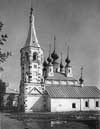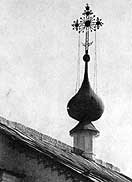| Виртуальный Владимир » Город Владимир » Old Russian Towns » Suzdal » Historic buildings » Church of St. Lazarus |
 ...
... On the way to the Cathedral of the Nativity
On the way to the Cathedral of the Nativity Cathedral of the Nativity
Cathedral of the Nativity Archbishops palace and bell-tower
Archbishops palace and bell-tower Church of St. Nicholas
Church of St. Nicholas Church oi St. Boris and St. Gleb
Church oi St. Boris and St. Gleb Monastery of St. Dmitri
Monastery of St. Dmitri Church of St. Nicholas
Church of St. Nicholas Church of St. Cosmas and St. Damian
Church of St. Cosmas and St. Damian Church of the Sign
Church of the Sign market place
market place Church of John the Baptist
Church of John the Baptist Church of the Entry into Jerusalem
Church of the Entry into Jerusalem Gostiny Dvor
Gostiny Dvor Church of the Resurrection
Church of the Resurrection Church oi the Emperor Constantino
Church oi the Emperor Constantino Church of St. Lazarus
Church of St. Lazarus Convent of the Deposition of the Robe
Convent of the Deposition of the Robe Holy Gates
Holy Gates Cathedral of the Deposition of the Robe
Cathedral of the Deposition of the Robe Trinity Cathedral
Trinity Cathedral Monastery of St. Alexander
Monastery of St. Alexander brick kiln
brick kiln Church of Tanners Settlement
Church of Tanners Settlement Church of Our Lady of Tikhvin
Church of Our Lady of Tikhvin Church of St. Peter and St. Paul
Church of St. Peter and St. Paul Convent ot the Intercession
Convent ot the Intercession Church of the Conception
Church of the Conception Spaso-Yevfimiev Monastery
Spaso-Yevfimiev Monastery Cathedral oi the Transfiguration
Cathedral oi the Transfiguration Church of Our Lady of Smolensk
Church of Our Lady of Smolensk 17th century house
17th century house Monastery of St. Basil
Monastery of St. Basil Yuri Dolgorukys castle
Yuri Dolgorukys castle Church oi St. Boris and St. Gleb
Church oi St. Boris and St. Gleb Let us now make our way to the Convent of the Deposition of the Robe along Old Street (Staraya Ulitsa) which leads from the market place to the monastery. On the right-hand side we see the Church of St. Lazarus.
Let us now make our way to the Convent of the Deposition of the Robe along Old Street (Staraya Ulitsa) which leads from the market place to the monastery. On the right-hand side we see the Church of St. Lazarus.
There was a wooden church of the same name on this spot by the north gates of the stockade in the fifteenth century, which possessed a tent-shaped spire at the beginning of the seventeenth century. The present five-domed church built in 1667 has an exterior typical of many seventeenth-century churches. It has a cube-shaped main body with three apses, differently designed portals on each wall, a rich cornice of horseshoe-shaped kokoshniks and a band of tiling. The same kokoshnik motif decorates the bases of the corner dome drums and the drums themselves are adorned with a band of blind arcading. Unlike most churches of this type, however, where the corner dome drums do not have windows, all five drums possess them. This is explained by the church's unusual two-pillared construction. Inside it has two pillars supporting two pairs of longitudinal arches suspended between the east and west walls. The arches are vaulted and the drum of the dome stands on small pendentives in a space in the central vaults between the pillars. This kind of construction was known as early as the sixteenth century and first appeared in the northern towns beyond the Volga from whence it spread to the Volga area. The existence of such a building in Suzdal suggests that it may have been the work of builders from the north, possibly from Vologda. The cathedral in the Monastery of St. Basil, built slightly earlier, can possibly also be ascribed to them. We shall see the latter towards the end of our tour of Suzdal.
 The main church forms a pair with the heated Church of Si. Antipius built a century later in 1745, which has a fine decorative crest of open metalwork running along the ridge of the roof. At its west end it is adjoined by a very attractive, slender bell-tower which appears to have been erected somewhat earlier and has a concave tent-shaped spire typical of Suzdalian architecture and round lucarnes. It is very similar to the bell-tower of the Church of St. Nicholas in the kremlin. When this group of buildings was restored by Alexei Varga-nov in 1959 the bell-tower was repainted in its original bright colours making it stand out from the other Suzdal bell-towers. The fashion for ordering buildings to be decorated in bright colours was typical of an earlier period, the seventeenth century.
The main church forms a pair with the heated Church of Si. Antipius built a century later in 1745, which has a fine decorative crest of open metalwork running along the ridge of the roof. At its west end it is adjoined by a very attractive, slender bell-tower which appears to have been erected somewhat earlier and has a concave tent-shaped spire typical of Suzdalian architecture and round lucarnes. It is very similar to the bell-tower of the Church of St. Nicholas in the kremlin. When this group of buildings was restored by Alexei Varga-nov in 1959 the bell-tower was repainted in its original bright colours making it stand out from the other Suzdal bell-towers. The fashion for ordering buildings to be decorated in bright colours was typical of an earlier period, the seventeenth century.
Оставить комментарий:



 Виртуальный Владимир
Виртуальный Владимир Область
Область Панорамы города
Панорамы города Организации
Организации Улицы и дома
Улицы и дома Добавить организацию
Добавить организацию О городе
О городе










